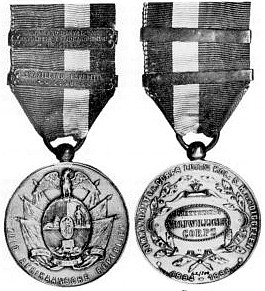Johannesburg Vrijwilliger Corps Medal facts for kids
The Johannesburg Vrijwilliger Corps Medal is a special award from a long time ago in South Africa. It was created in 1899 by Lieutenant Colonel S.H. van Diggelen. He was the leader of a group called the Johannesburg Vrijwilliger Corps. This medal was given to the brave soldiers in his unit for their volunteer military service. It's known as an "unofficial" medal because the government didn't formally create it.
Contents
The Volunteer Corps: A Special Group
In 1894, three volunteer groups were started in the Zuid Afrikaansche Republiek. This was an old name for a part of South Africa. These groups were in Pretoria, Johannesburg, and Krugersdorp.
The Johannesburg Vrijwilliger Corps was started by Mr. S.H. van Diggelen. He even paid for most of it himself! President Paul Kruger made him the commander, giving him the rank of lieutenant colonel. The first meeting to form the group was on 18 September 1894. This date is even shown on the medal! The Corps officially stopped operating on 1 January 1899.
Important Actions of the Corps
The Johannesburg Vrijwilliger Corps took part in two big events. They helped keep peace and order in the region.
Stopping the Jameson Raid
The first event was at Doornkop from December 1895 to January 1896. The Corps helped stop a planned uprising in Johannesburg. They also fought against the Jameson Raid. This was an attempt by some British people to take over the government of the Zuid Afrikaansche Republiek. It was not successful.
The Swaziland Expedition
The second big event was the Swaziland Expedition in 1898. This happened after a leader named Mbaba was killed in Swaziland. At that time, the government of the Zuid Afrikaansche Republiek looked after Swaziland. The Corps mainly patrolled the area to keep things peaceful.
Between these two actions, Van Diggelen also offered his unit's help. He offered it to the British during the Second Matabele War in 1896. However, his offer was politely turned down.
How the Medal Was Created
Lieutenant Colonel Van Diggelen created the Johannesburg Vrijwilliger Corps Medal in 1899. He wanted to reward the officers and soldiers of his Corps. The medal has the official symbol of the Zuid Afrikaansche Republiek. This might make it seem official, but Van Diggelen actually paid for the medals himself.
The medals were given out after the Swaziland Expedition finished. Two special bars, called "clasps," were also awarded. These clasps were for the "Jameson Inval en Revolutie te Johannesburg 1895–1896" and the "Swazieland Expeditie 1898." We don't know exactly how many medals were given out. However, only ten of these medals are known to still exist today!
What the Medal Looks Like
The medal is a round, bronze disk, about 4.7 centimetres wide. It weighs about 48 grams. A bronze ring at the top lets it hang from a ribbon. The medals were made in Holland by a company called Begeer.
Front of the Medal (Obverse)
The front of the medal shows the official symbol of the Zuid Afrikaansche Republiek. Around the bottom edge, it says "ZUID AFRIKAANSCHE REPUBLIEK".
Back of the Medal (Reverse)
The back of the medal has a fancy design in the middle. It says "JOHANNESBURG VRIJWILLIGER CORPS". This is surrounded by two laurel branches, which are symbols of victory. At the top, it says "COMMANDANT V.H. CORPS LUITNT KOL: S. H. VAN DIGGELEN". This means "Commander of the Corps Lieutenant Colonel S. H. Van Diggelen". At the bottom, you can see the years "1894-1899". The name of the company that made it, "BEGEER UTRECHT", is also written there.
The Clasps
The two clasps are also made of bronze. They are designed to slide onto the medal's ribbon. The first clasp is about 8.3 millimetres high. It says "JAMESON INVAL EN REVOLUTIE TE JOHANNESBURG 1895-1896". The second clasp is about 7 millimetres high. It says "SWAZIELAND EXPEDITIE 1898".
The Ribbon
The ribbon for the medal is about 3.8 centimetres wide. It has four equal stripes of bright grass-green, scarlet (red), white, and deep sky-blue. These colours are the same as the old Transvaal Vierkleur flag.
Why This Medal Is Important
Even though this medal was not officially created by the government, it is still very important. It is one of a few special medals from that time that are well-known in South Africa's military history. These unofficial medals were not allowed to be worn with military uniforms. However, they are still remembered for their significance.
The Johannesburg Vrijwilliger Corps Medal is considered one of four very important unofficial medals.
- The Sir Harry Smith's Medal for Gallantry from 1851.
- The Johannesburg Vrijwilliger Corps Medal from 1899.
- The Kimberley Star from 1900.
- The Cape Copper Company Medal for the Defence of O'okiep from 1902.



